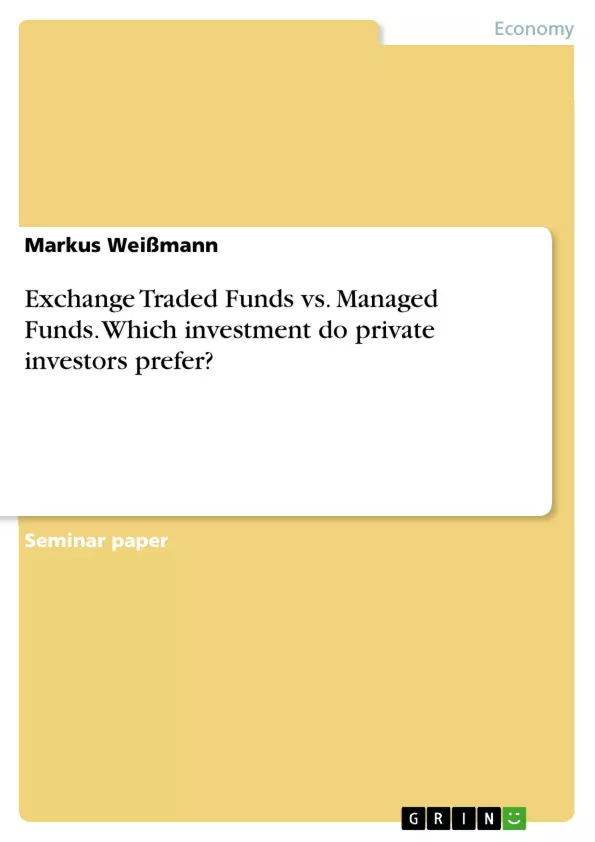This term paper wants the reader to get an idea of what asset investors would prefer if they had the choice between Exchange Traded Funds and Managed Funds. Therefore, the author starts with giving an overview about these two assets including basic information, special key facts and some numbers, that show the relevance within the current capital market. After that the term paper includes a chapter about the research method as the research question will be answered with a questionnaire, which will give subjectively information by volunteer private investors. This part will be followed by an explanation about the evaluation method, at which the collected information will be analyzed and compared. Then the questionnaire`s results will be evaluated, separated into general part, ETF-part and MF-part. With the help of a self-created scorecard the preference of the interviewed people will be shown. Last but not least the author will give a conclusion, in which he will shortly summarize the content of the previous chapters and will show the final result regarding the research question.
If you don`t find a way to make money while you sleep, you will work until you die.”1 This quote belongs to the US star investor Warren Buffet and inspires people all over the world to invest their money to get gain in value as well as passive income. To reach these goals people put their savings in several investment assets within a special kind of market. The capital market is a place with millions of participants, who invest in shares, bonds, properties, currencies, commodities and many more alternatives. Even digital currencies like the cryptocurrency Bitcoin is getting an interesting instrument to invest in. The universe of products that promise monetary benefits to investors is quite big and difficult to oversee. One important asset class, which has not been mentioned in this text yet, does belong to funds.
Inhaltsverzeichnis (Table of Contents)
- Introduction
- What are Exchange Traded Funds?
- What are Managed Funds?
- Research method
- Evaluation method
- Evaluation Which investment class is preferred?
- General results
- Exchange Traded Funds
- Managed Funds
- Comparison
- Conclusion
Zielsetzung und Themenschwerpunkte (Objectives and Key Themes)
This term paper aims to provide insights into the investment preferences of private investors when choosing between Exchange Traded Funds (ETFs) and Managed Funds (MFs). The paper will explore key features, characteristics, and considerations for each investment type, culminating in an evaluation of investor preferences based on a questionnaire.
- Understanding the characteristics and benefits of ETFs and MFs
- Examining the research methodology used to gather investor preferences
- Analyzing and comparing the results of the questionnaire to determine the preferred investment class
- Presenting a conclusion that summarizes the findings and highlights the key factors influencing investor decisions
Zusammenfassung der Kapitel (Chapter Summaries)
- Introduction: This chapter provides a general overview of the capital market and the importance of investment choices, specifically focusing on the decision between ETFs and MFs.
- What are Exchange Traded Funds?: This chapter explains the concept of Exchange Traded Funds (ETFs), highlighting their features, benefits, and trading characteristics. It discusses key aspects like diversification, index tracking, and cost-effectiveness.
- What are Managed Funds?: This chapter delves into the definition and historical context of Managed Funds (MFs), emphasizing their role in the capital market and contrasting them with ETFs.
- Research method: This chapter outlines the research methodology used to gather information on investor preferences. The focus is on the questionnaire used to collect subjective opinions from private investors.
- Evaluation method: This chapter explains the methodology used to analyze the collected data and compare the preferences for ETFs and MFs. It describes the scoring system used to evaluate the results.
Schlüsselwörter (Keywords)
Key terms and concepts central to this term paper include Exchange Traded Funds (ETFs), Managed Funds (MFs), investment preferences, capital market, diversification, index tracking, cost-effectiveness, research methodology, questionnaire, data analysis, and investor behavior.
- Citation du texte
- Markus Weißmann (Auteur), 2020, Exchange Traded Funds vs. Managed Funds. Which investment do private investors prefer?, Munich, GRIN Verlag, https://www.grin.com/document/932831



